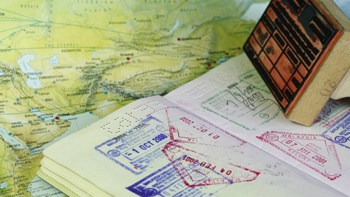
New Zealand has slipped down a global ranking of ''passport power'' which shows where Kiwis can enjoy visa-free or visa-on-arrival access.
The Henley Passport Index shows that while the number of countries New Zealanders can enter visa-free has increased in the last year, this country has slipped from fifth equal to seventh equal as other nations increase the number of such relationships.
Japan and Singapore share first place, with easy access to 189 destinations. Both countries gained access to Uzbekistan earlier this year, knocking Germany off the top spot into second place for the first time since 2013.
This is the first year in the index's 13-year history that either Japan or Singapore has had the most powerful passport in the world.
New Zealand, tied in seventh with the Czech Republic and Malta, has visa-free or visa-on-arrival access to 182 destinations, up from 172 last year.
The index is based on data from the International Air Transport Association.
Among more than 40 countries where Kiwi passport holders need visas are China (if staying longer than visa-waiver periods) Vietnam and Russia.
Passports on the index that access the fewest countries are from Afghanistan and Iraq — just 30 countries - and rank 102 on the list.
The so-called hermit state, North Korea, is ranked 94th with visa-free access to 43 destinations, up from 40 last year.
The impact of US President Donald Trump's anti-immigration stance has not been reciprocated by other countries.
The US and Canada are in the top five globally, but Latin American nations Chile, Argentina, and Brazil are not too far behind, in 13th place (Chile) and 15th place (Argentina and Brazil).
These countries have jumped as many as ten places since 2008, while the US and Canada have fallen slightly over time.
/arc-anglerfish-syd-prod-nzme.s3.amazonaws.com/public/F6P5QU2PJVC2ZLAD4K2JWRTQFU.jpg)
Dr Parag Khanna, managing partner of FutureMap, said that despite Trump's strict anti-immigration stance, he didn't expect any difficulties for American passport holders, unless countries such as Venezuela and Egypt that have been placed on Trump's travel ban list decide to implement visas for Americans.
''Countries with weak economies cannot afford to close out a nationality that provides large inflows of tourists, for example. Turkey learned this lesson in 2017 when it temporarily demanded that Americans apply for visas before travelling to Turkey."
Assistant professor of geography at Durham University Kate Coddington focuses on migration and governance in the Asia-Pacific.
She said the region continued to see a range of contradictory responses to increasing levels of mobility during the first quarter of 2018 from aggressive enforcement targeting
China's rural migrants in urban areas to signs that Australia and New Zealand could restrict international migration.
Some areas remained relatively stable such as South Asia and much of Southeast Asia, but other areas have seen substantial growth.
Rankings of countries in North Asia — including Japan, South Korea, Hong Kong, and Taiwan — indicated substantial growth.
In part, this could be driven by the possibility of reciprocal agreements: as North Asian countries relax travel and residence requirements, the mobility of their own citizens becomes increasingly attractive to others.
''For instance, Japan loosened restrictions on permanent residence requirements in 2017, hoping to increase the number of skilled migrants who qualify for residence from just over 8000 currently to 20,000 by 2022. Taiwan similarly relaxed rules for foreign skilled workers and their family members in 2018, easing requirements for work permits and permanent residence applications,'' she said.
''At the same time, travellers from North Asian countries were able to access more visa-free travel opportunities in countries such as Uzbekistan, Macedonia, and the UAE.''
Much of Oceania has also seen significant growth driven in particular by Pacific island nations such as the Solomon Islands, Vanuatu, and Tuvalu.
Some of this optimism may be attributed to increasing signs of openness between Australia and Pacific island nations, such as the development of the Pacific Labour Scheme in late 2017 to allow residents of Pacific islands to live and work in Australia.
''(This) indicates a move towards greater regional flexibility in migration governance even as broadly restrictive rhetoric towards migrants still dominates Australian political debates.
/arc-anglerfish-syd-prod-nzme.s3.amazonaws.com/public/CAXSTFEAORDHPNXAWWYN5Y7K3Y.jpg)
Countries such as Singapore, Malaysia, and Brunei continued to grow, suggesting that nationals of these countries continue to be attractive short and longer-term visitors to destinations as varied as Uzbekistan, which opened visa-free travel to citizens of Malaysia and Singapore in 2018, and Russia, which waived visas for citizens of Brunei in 2018.
Coddington said developments to watch in the Asia-Pacific region this year included China's continued push towards easing access to parts of the country for tourists, such as its recent move to open the Hainan province to visa-free travel for residents of 59 countries.
''Globally, we should continue to see efforts by smaller nations to marketing citizenship opportunities in the wake of ongoing restrictions on international migration championed by the US, the UK, and other traditional migrant destinations in the global north.''
China strengthens its travel links with key investment destinations.
China is climbing up the rankings as its ranked 68 with 72 destinations, up from 85th with 51 destinations.
Khanna said China had been successfully tying its investment strategy to its diplomatic and consular priorities, especially in developing countries and emerging markets.
''Given China's focus on Belarus as a node on the 'Belt and Road', this is an expected development. Meanwhile, the shift in government in Zimbabwe and other African countries signals an openness to foreign investment from all directions, including China."
China is Zimbabwe's fourth largest trading partner.
According to the World Tourism Organisation and the China National Tourism Association, Chinese citizens last year made 120 million trips — and spent
US$215 billion ($NZ$315B) — abroad. That makes China the largest tourism market in the world.
Henley & Partners helps migrants with residence and citizenship planning around the world
Take your Radio, Podcasts and Music with you









